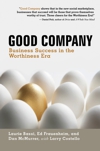Good Company ties together the lessons we’re still learning from The Great Recession, and explains what’s fueling the occupy movements, shows how social responsibility and environmentalism is dramatically shifting business approaches, and identifies the rising power of customers. Good Company is an inspiring and uplifting read for those of us working to bring about a values-based leadership revolution. It’s fairly bubbling over with hope, optimism, and deep insights into the change tsunami washing around the globe.
Good Company is an inspiring and uplifting read for those of us working to bring about a values-based leadership revolution. It’s fairly bubbling over with hope, optimism, and deep insights into the change tsunami washing around the globe.
Critics of this book will likely try to dismiss it as left wing propaganda describing an unrealistic utopia. I can hear these old world managers (the anti-leaders) now: “that’s not the reality of how the business world works. Good guys finish last.”
Unfortunately, for old school managers — and thankfully for the rest of us — Good Company builds many of its arguments around solid research. These are deep and profound global trends that can’t easily be blown off with ideological platitudes:
- “Nearly six in ten global consumers polled in 2009 said a company or brand earned their business during the recession because it has been doing its part to support good causes…
- Nearly three out of four Americans surveyed in 2010 said they are more likely to give their business to a company that has fair prices and supports a good cause than to a company that provides deep discounts but does not contribute to good causes…
- 37 percent of Americans would punish a company that doesn’t actively support a good cause by sharing negative opinions and experiences, while 47 percent would not invest in such a company…
- 84 percent of consumers in China, India, Malaysia, and Singapore say they would accept a higher price for a green product …
- Globally, 56 percent of people want a job that allows them to give back to society versus 44 percent who value personal achievement more…”
Two of the authors, Laurie Bassi and Dan McMurrer, are organization effectiveness researchers, consultants, and run an investment fund based on the principles outlined in Good Company. They used their Good Company Index to rank the Fortune 100 (largest 100 companies on the Fortune 500 list of America’s largest corporations). It’s based on calculating scores for Good Employer (from Glassdoor.com), Good Seller (wRatings using customer evaluations of quality, fair price, and trust), and Good Steward (environment, penalties/fines, CEO compensation, use of tax havens, and society/community contributions).
The two companies in the “highest” category were United Parcel Service and Walt Disney. About 25 companies were rated “high.” Some of these included IBM, FedEx, Dell, Procter and Gamble, Best Buy, and 3M. Three companies in the “lowest” category were Philip Morris, Prudential Financial, and Sunoco. Some of the 20 companies in the “low” category included Berkshire Hathaway, Exxon Mobil, News Corp, Dow Chemical, and General Dynamics.
“When we compared pairs of Fortune 100 companies within the same industry, we found that those with higher scores on the Good Company Index outperformed their peers in the stock market over periods of one, three, and five years.”
Ultimately, Good Company shows how a strong leadership culture that’s serving all of its stakeholders and society pays off for everyone buying from, working for, investing in, and doing business with the company. Traditional management that’s narrowly focused on serving shareholders (and usually senior executives) fails to provide sustained profitability compared to their better led peers. And everyone else is worse off.
At times the authors go over the top with unsubstantiated theories and wild conjectures about where the world is headed. Nobody can predict the future and extrapolating today’s trends forward inevitably proves to be way off the mark.
But they build a very strong case that good guys finish first:
“We’re losing patience with bad companies …we are entering a new economic age. We call it the Worthiness Era. In it, companies face mounting pressures to prove themselves worthy of their employees, customers, and investors. In order to do so, they must combine competitive savvy with a genuine desire to do more than maximize short-term profits or enrich a narrow circle of stakeholders. And then they must back up those good intentions with actions. It’s an era based fundamentally on reciprocity. Put simply, companies must demonstrate they care about people and the planet if they are going to prosper … companies ‘can do well by doing good’ requires an update. Companies will not be able to do well unless they do good. What has been a nice-to-have over the past decade or so is becoming a necessity.“
Good Company is a good read with more good evidence that multi-dimensional values-based leadership takes us all to good places.
For over 30 years, Jim Clemmer’s practical leadership approaches have been inspiring action and achieving results. He has delivered thousands of keynote presentations, workshops, and management team retreats to hundreds of organizations around the globe moving his audiences from inspiration to application. He’s listed in the World’s Top 30 Most Influential Leadership Gurus based on research with 22,000 global business people, consultants, academics and MBAs. His website is www.JimClemmer.com.

Be the first to comment on "Book Review: Good Company"